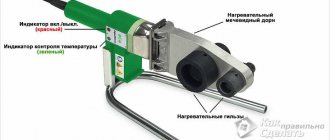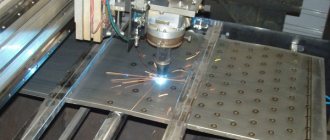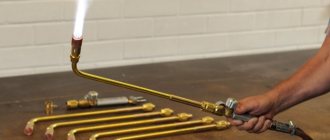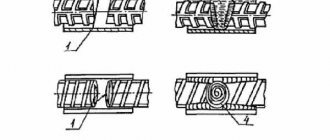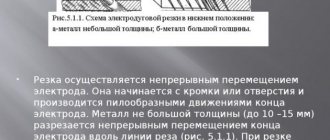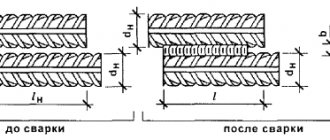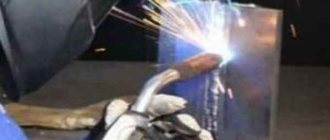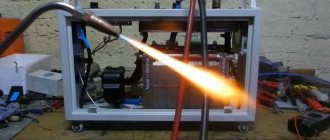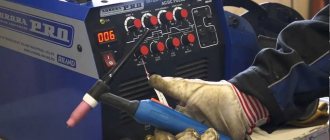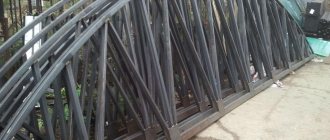What is the aluminothermic method?
Aluminothermic welding is a rail joining technology. It implies the use of a special connecting mixture . It is poured into a metal structure installed above the connection point. The powder falls on the work surface, melts, and creates a reliable connection. There are two options for carrying out the work:
- Joint path.
- Seamless path.
During the work, thermite mixture is used . It consists of 77% iron oxide and 23% aluminum chips. However, the working substance will not create a strong seam without strong heating. For this, an igniter is used, which heats the mixture. Aluminothermic welding of rails must be carried out according to strict adherence to technology.
Upon completion of the seam, the slag, protruding parts, and sagging are cleaned off using a grinder. The welder checks the integrity of the connection. If there are gaps, cracks, cracks, he covers them with heat-resistant coating.
To create a reliable seam that will withstand heavy loads, special presses are used. With their help, the process of compacting the connecting mixture is carried out.
Aluminothermic welding of rails: description, equipment, advantages and disadvantages
Welding rail joints is a technological process that can be performed using different methods. Classic methods of joining metal parts are considered inappropriate, since after completing the work, an unreliable seam for the rail surface is obtained. In this case, aluminothermic welding is the most effective.
What is the aluminothermic method?
Aluminothermic welding is a rail joining technology. It implies the use of a special connecting mixture . It is poured into a metal structure installed above the connection point. The powder falls on the work surface, melts, and creates a reliable connection. There are two options for carrying out the work:
- Joint path.
- Seamless path.
During the work, thermite mixture is used . It consists of 77% iron oxide and 23% aluminum chips. However, the working substance will not create a strong seam without strong heating. For this, an igniter is used, which heats the mixture. Aluminothermic welding of rails must be carried out according to strict adherence to technology.
Upon completion of the seam, the slag, protruding parts, and sagging are cleaned off using a grinder. The welder checks the integrity of the connection. If there are gaps, cracks, cracks, he covers them with heat-resistant coating.
To create a reliable seam that will withstand heavy loads, special presses are used. With their help, the process of compacting the connecting mixture is carried out.
What is included in the mixture?
Thermite is used not only for welding rails. They are used for thermal effects on various surfaces, detonator effect, and the manufacture of pyrotechnic products. Depending on where thermite is used, the composition of the mixture is chosen.
Aluminothermic welding of railway joints is performed using a ferroaluminum composition . It includes components such as iron oxide (metal filings), aluminum. The percentage of components is 75%/25%. In this case, the amount of active substances may vary +-3%.
Important! Welding of rails is carried out with a mixture of aluminum and iron. Both components are contained in fine sawdust. To speed up the burning process of the connecting composition, aluminum is added in the form of powder.
How to prepare thermite yourself?
A mixture for aluminothermic welding can be made at home . To do this, you need to prepare two components:
Both components should be fine sawdust. The smaller their fraction, the better the finished mixture will be. Stages of preparing thermite:
- In a metal container, mix 4 parts iron filings, 2 parts aluminum powder.
- Mix the ingredients thoroughly. The quality of the finished composition depends on the mixing process.
- Additionally, the mixture must be saturated with a catalyst. It is made from burnt potassium permanganate. It is required to add a fifth of this substance to the composition.
Dry the finished mixture. It is ignited using magnesium tape. Thermite can be transported and stored using metal containers.
Materials used
In addition to the equipment, it is necessary to prepare consumables. This is a thermite mixture, a coating composition for sealing cracks and crevices. In addition to them, you need two forms, an applicator, a core, and a punch.
Sequence of work
Before you begin connecting work, you need to learn theoretically how to weld rails, and then try the method in practice. The technology consists of several stages that must follow strictly one after another.
Installation and sealing of forms
It is important to carry out connection work using a sealed form. Using a meter, the clamping device is installed at the required distance from the future seam. The burner is installed in the center of the connection.
Preheating and welding
It is first necessary to warm up the rails to be connected. The flame supply (propane and oxygen) is turned on for 2 minutes. The burner needs to be removed and the core secured. The fuse is turned on to ignite the working mixture. The molten metal is poured into a pre-prepared mold. Four minutes is enough for complete crystallization.
Other types of rail welding
In addition to aluminothermic welding, there are other technologies for connecting rails. These include:
- Welding with electrodes . In order to connect rails with this technology, it is necessary to use SSSI electrodes. Before carrying out work, it is necessary to warm up the consumables for 2 hours at a temperature of 400 degrees.
- Electric arc welding . The connected rails are laid opposite each other. In this case, there should be a gap of 2 cm. The ends of the rails are welded with electrodes. They are melted by an arc discharge.
- Intermediate casting method . It involves the process of filling the connecting space with a molten mixture of metals.
When performing work using a certain technology, you need to choose equipment and consumables wisely.
Methods for welding rail strands
The technology is an innovative method of connecting rails. Stages of work:
- The rails are installed opposite each other with a gap.
- One of the loose ends is bent until the ends match.
- Next, the rails are welded together.
- The bending arrow is forced to straighten.
This technology is used to repair railway tracks.
Aluminothermic welding is used to join rails. With its help you can make a reliable seam that will withstand serious loads. In addition, other joining technologies can be used, however, classical welding is not suitable for performing such work.
Welder 4th category Mikhail Vasilyevich Chernov, 37 years old, 14 years of work experience: “When connecting rails, you need to be extremely careful about the choice of equipment and termite. A poor-quality mixture can cause a violation of the integrity of the railway track and, as a result, a disaster. It is advisable to use intermediate casting technology, as it is considered the most reliable and durable.”
Loading…
Source: https://greendom74.ru/svarka/metod-promezhutochnogo-litya-dlya-alyuminotermitnoy-svarki-relsov
Joint path
To reduce the number of rail joints on a track, for decades there has been an effort to increase the standard length of rails. The fundamental solution to the problem of rail joints was embodied in the so-called continuous track, thanks to which the number of joints is reduced by tens, and when welding rails at hauls, stations and within turnouts, by thousands of times.
Continuous path
Continuous track is the most progressive and advanced type of railway track.
It allows:
- impacts of wheels on rails when rolling through gaps in joints are eliminated and, consequently, wear of rails and wheels is significantly reduced;
- save metal by reducing the number of butt fasteners;
- reduce the dynamic impact on the track that occurs at the joints;
- reduce wear on rails and rolling stock chassis;
- reduce rail failure due to joint defects;
- reduce resistance to train movement;
- reduce the costs of maintaining and repairing tracks and rolling stock.
What is included in the mixture?
Thermite is used not only for welding rails.
They are used for thermal effects on various surfaces, detonator effect, and the manufacture of pyrotechnic products. Depending on where thermite is used, the composition of the mixture is chosen. Aluminothermic welding of railway joints is performed using a ferroaluminum composition . It includes components such as iron oxide (metal filings), aluminum. The percentage of components is 75%/25%. In this case, the amount of active substances may vary +-3%.
Important! Welding of rails is carried out with a mixture of aluminum and iron.
Both components are contained in fine sawdust. To speed up the burning process of the connecting composition, aluminum is added in the form of powder.
Kinds
There are two different methods of thermite welding - crucible and muffle. Their use is determined by the working conditions and the materials being connected. The first type of welding is also called aluminothermic and is used in the assembly of various metal structures and grounding loops. Thermite for this type of welding is prepared from aluminum powder and iron oxide. The ratio is 23:70 respectively. During the combustion process, iron is reduced from scale, the melt of which joins the workpieces.
In addition, aluminothermic welding is very often chosen for repairing metal surfaces using the surfacing method. The main advantage of this method is the ability to connect cast iron blanks without joints. It is impossible to form seams on aluminum elements using this joining method. To connect them, it is better to resort to another type of welding.
For muffle welding, magnesium-based thermite is used, since aluminum evaporates under high temperature. Magnesium has a high melting point, so it does not spread on the surface. The result is a strong welded joint without a seam. When aluminum billets are welded, a special flux is used to get rid of the oxide layer.
Thermite welding is performed in one of four ways:
- Butt. Thorough preparation is required in advance. The surface of the workpieces is thoroughly cleaned. To avoid unwanted deformation of the workpieces, the parts are wrapped with a special film. After the thermite burns, a melt is obtained. From the crucible it is poured into the joint space between two workpieces. The parts are tightly compressed together.
- Intermediate casting. The technique is used to connect parts fixed in a certain spatial position. This is the simplest connection option. The melt pre-prepared in the crucible fills the space between the two workpieces.
- Combined. The method combines two types of welding. Used for repairing railway tracks. The ends of the rails are pre-cleaned, after which the joint is formed using metal mold plates. A closed cavity is formed into which the melt is poured. The rails are compressed. After the melt has solidified, the joint around the perimeter is boiled again.
- Duplex. Classic crucible welding plus additional crimping of joints.
How to prepare thermite yourself?
A mixture for aluminothermic welding can be made at home . To do this, you need to prepare two components:
- Aluminum.
- Iron.
Both components should be fine sawdust. The smaller their fraction, the better the finished mixture will be. Stages of preparing thermite:
- In a metal container, mix 4 parts iron filings, 2 parts aluminum powder.
- Mix the ingredients thoroughly. The quality of the finished composition depends on the mixing process.
- Additionally, the mixture must be saturated with a catalyst. It is made from burnt potassium permanganate. It is required to add a fifth of this substance to the composition.
Dry the finished mixture. It is ignited using magnesium tape. Thermite can be transported and stored using metal containers.
Thermite treatment
Aluminothermic technology has been tested by time. The use of thermite welding of rails is based on a reducing reaction that occurs when the base (aluminum) comes into contact with another component - iron oxide.
The resulting metal (reduced iron) at operating temperatures of about 2000 degrees is poured into a special fire-resistant form that matches the geometry of the rails being welded.
This reaction is accompanied by the release of a significant amount of thermal energy.
Welding rails using the thermite method began a very long time ago (from the mid-19th century), but since then this type of welding, due to the use of aluminum, began to be called aluminothermic.
It is important to note that the described chemical reaction after igniting a special high-temperature fuel (thermite) lasts only a few seconds.
In addition to the two components considered (iron and aluminum oxide), alloying additives and small steel particles are introduced into the working welded mixture, which slightly slow down or dampen the ongoing process. Additives are necessary to ensure that the steel in the welding zone acquires the required qualities and parameters characteristic of most rail products.
When considering the features of this type of welding process, it should be noted that upon completion of the reaction, the total chemical mass is divided into two fractions: liquid metal and light slag, which floats to the top of the mold.
Termitan technology allows the following types of track products to be connected to each other:
- surface-hardened rail blanks;
- volumetrically hardened joining parts of rails,
- rails that have not undergone special heat treatment in any combinations.
This type of welding ensures compliance with the requirements of the basic standards for high-speed rail lines, in terms of compliance with welding technology standards.
Advantages and disadvantages
Any technology for joining metal parts has strengths and weaknesses. Benefits include:
- High speed of work completion. With enough experience, a high-quality joining mixture, and the right equipment, the welder will make a reliable weld in less than half an hour.
- Equipment and tools can be bought at construction stores.
- To master the technique, it is enough to try the aluminothermic welding method 2-3 times.
Flaws:
- It is required to work carefully with welding equipment and thermite. This is due to the fact that the mixture is highly flammable.
- The technology is highly specialized. Not suitable for joining most metal structures.
- It is necessary to store, transport, and use thermite very carefully.
If the working mixture catches fire, it will not be possible to extinguish it. The water will only splash the burning mass around.
Weld seams in cars, locomotives, rails and machines for various purposes used in transport are the most damaged areas during operation. This is due to the characteristic features of welded joints. In the weld and heat-affected zone after welding, the mechanical properties change. When welding using the thermite method, residual tensile stresses are formed that are close to the yield strength of the material, and the weld itself, in addition, is a stress concentrator
Thermite pencils
Thermite pencils can be found on sale. This is a piece of carbon steel wire with a diameter of up to 5 mm. A thermite mixture mixed with glue is applied to it. On one side of the pencil there is a place for a fuse. Something like Bertholet cord, but applied as a path on the pencil itself. The pencil is inserted into the holder - as for electric welding - and the upper part is set on fire. When the fire reaches the base compound at the other end of the pencil, thermite fuse occurs. Welding must be done with a protective shield and gloves. The same pencil is used to ignite the main mixture in the crucible. It is set on fire and thrown into a crucible with the thermite mixture.
In addition to pencils, there are also thermite blocks and cartridges. They operate on the same principle as a thermite pencil.
Advantages of thermite welding
- strong and reliable welding joint with high resistance to destruction;
- welding technology is simple and accessible, which implies its use both in industry and in everyday life;
- the most optimal welding option in emergency situations.
Flaws
- high moisture absorption;
- the mixture, due to its ability to ignite, is considered a fire hazard, which requires careful handling and storage;
- moisture getting on a thermite block leads to an explosion;
- inability to control thermite combustion process.
Sequence of work
Before you begin connecting work, you need to learn theoretically how to weld rails, and then try the method in practice. The technology consists of several stages that must follow strictly one after another.
Preparatory stage
First of all, it is necessary to prepare the parts to be connected. To do this, the rails are released from their fastenings, heated to a certain temperature, and cleaned of rust. The surface must be smooth. Next, the rails are installed opposite each other so that the gap does not exceed 2.5 cm.
Alignment
During aluminothermic welding, precise straightness is required. This is due to the fact that the rails will be subject to enormous loads when loaded trains move. The gaskets on the fastenings are replaced with wedges. Next, workers use hammers to hammer the rails to the desired position. Straightness is checked with a metal ruler. Allowable gap is 1 mm.
Installation and sealing of forms
It is important to carry out connection work using a sealed form. Using a meter, the clamping device is installed at the required distance from the future seam. The burner is installed in the center of the connection.
Preheating and welding
It is first necessary to warm up the rails to be connected. The flame supply (propane and oxygen) is turned on for 2 minutes. The burner needs to be removed and the core secured. The fuse is turned on to ignite the working mixture. The molten metal is poured into a pre-prepared mold. Four minutes is enough for complete crystallization.
Sanding and quality control
The final stage of work is grinding the seam. Before using the rails, it is necessary to make the surface smooth. The seam is heated using a burner for 10 minutes. Hot spots are cut off with a grinder. After the joint has cooled, grinding is performed. For this purpose, grinding machines with abrasive wheels or belts are used. Quality control is a static bend test.
Aluminothermic welding
The process of welding rails can be carried out in several ways: electric arc, gas press, aluminothermic welding. The latter technology is the most popular and is considered very effective, although the contact method is also often used. Aluminothermic welding of rails involves the use of a special device - an igniter. Due to a single-portion charge, the temperature regime increases (up to 1000°C), which is suitable for melting all types of rails.
Welding rail joints is a difficult process that requires maximum concentration and care. Since the web material contains a lot of carbon, it is considered a difficult-to-weld metal. By making mistakes in creating a rail weld, you can get cracks in the joint. We will discuss the essence of this type of welding in this article.
articles
- What is aluminothermic welding?
- Advantages and disadvantages
- Equipment
- Sequence of work: Preparatory stage
- Alignment
- Installation
- Heating and welding
- Sanding and quality control
What is aluminothermic welding?
The method is as follows: a special powder is placed in a special metal structure, which is located above the junction of two sections of the fabric being welded, and then this powder melts. The purpose of the powder is that it reliably and firmly connects the base material and thus the microstructure of the seam becomes very viscous. Such joints are made very quickly and over time they do not sag, which indicates their high quality.
The powder, which acts as a binder in thermite welding of rails, consists of 23% aluminum chips and 77% iron oxide. The powder structure is finely dispersed, granule size is 0.5 mm. The technology is based on the ability of the metal to be reduced in aluminum oxides. However, as already noted, this can only happen at high temperatures, which is why an igniter is used, through which the mixture is ignited. It is this process that turns iron oxide into pure metal.
A casting mold is used at the site, thanks to which the alloy is directed to the joint.
Note! It is very important that a sealed structure be formed, which is why special different shapes have been created for different rail configurations.
If, after completing the work, you find some gaps and cracks, then you need to get rid of them; for this, heat-resistant coating is used. Due to its liquid consistency, it flows into the butt joint area and fills the free space. As a result, slag forms on the surface.
The process of creating a rail weld must be carried out with the obligatory sealing of the joint when it is still hot. To do this you need to get presses. Upon completion of the work, the slag must be beaten off with a hammer, and the seam itself must be sanded with a special machine and grinder.
Advantages and disadvantages
Aluminothermic welding of rails is very often used in practice; its wide popularity is due to a number of advantages that stand out when using this method:
- The process is carried out very quickly (no more than 30 minutes). Several experienced welders can create 10-12 seams in 1 hour.
- Welding work may not require connection to stationary sources of electricity.
- All necessary parts and tools can be purchased at any hardware store.
- To weld a rail well, in principle, you do not need any special education; it is enough to practice several times to make the connection strong and reliable.
- If you strictly follow the rules for performing the technology for creating a seam, you will ultimately get a connection that will withstand heavy loads.
- Provided that good technique is used, the process is considered completely safe for the people doing the work.
- Thermite welding of rails does not require strict connection to a populated area; it can also be carried out in the field.
Despite the large number of advantages, like any other technology, welding work based on the use of aluminothermy has its disadvantages, which cannot be ignored:
- Since the powder used is flammable, extreme care should be taken when handling it.
- In order to ultimately get a high-quality seam, you need to pay special attention to preparation and complete it in detail.
- Make sure the equipment is in good working order.
- You need to be very careful, because if water gets into the burning container, the metal will splash.
Equipment
Aluminothermic welding should be carried out only if all the necessary elements are present: a barrel, powder, a plug, a shape that is made in accordance with the configuration of the rails, a coating substance necessary to seal the joint, a grinder, a chisel, a hammer, a metal spatula (needed to remove the burning slag), burner (using it, you must initially heat the metal).
Preparatory stage
A significant role in how to weld a rail seam is played by preparation, which involves the following actions: near the joint, the rail fastenings must be loosened, and those located at the joint area must be completely removed. Next, using a burner, the rails are heated and also cleaned of rust. At the next stage, using wedges, they must be straightened both horizontally and vertically. The rails must be installed maintaining a gap of 2.5 mm, then a cutter is brought to them.
Alignment
Initially, you need to get rid of the gaskets of all fasteners, wedges are installed in their places, using a hammer they need to be adjusted to the required condition. Then you need to check how accurately the rails are laid; to do this, use a meter ruler.
Installation
At this stage, it is important to select the desired sealed form, then the burner must be placed in the middle in the area where the seam is expected to appear. You also need to seal the gaps; to do this, the mold must be pressed as tightly as possible against the seam; a spatula is also used here, which ensures a clean edge between the seam and the sand.
Heating and welding
Pre-heating of the rails is carried out with a burner at the following parameters: propane pressure – 1.5 bar, oxygen pressure – 5 bar. The flame is supplied for 1.5 - 2 minutes. When heating is complete, the burner is removed, the core is inserted and the crucible is turned. Then, at the site of the intended joint, a special barrel filled with charge is installed. In order to ignite the charge, a high-temperature fuse is used, then the liquid metal is placed in a mold and held for 4-5 minutes.
Other types of rail welding
In addition to aluminothermic welding, there are other technologies for connecting rails. These include:
- Welding with electrodes . In order to connect rails with this technology, it is necessary to use SSSI electrodes. Before carrying out work, it is necessary to warm up the consumables for 2 hours at a temperature of 400 degrees.
- Electric arc welding . The connected rails are laid opposite each other. In this case, there should be a gap of 2 cm. The ends of the rails are welded with electrodes. They are melted by an arc discharge.
- Intermediate casting method . It involves the process of filling the connecting space with a molten mixture of metals.
When performing work using a certain technology, you need to choose equipment and consumables wisely.
Methods for welding rail strands
The technology is an innovative method of connecting rails. Stages of work:
- The rails are installed opposite each other with a gap.
- One of the loose ends is bent until the ends match.
- Next, the rails are welded together.
- The bending arrow is forced to straighten.
This technology is used to repair railway tracks.
Aluminothermic welding is used to join rails. With its help you can make a reliable seam that will withstand serious loads. In addition, other joining technologies can be used, however, classical welding is not suitable for performing such work.
Welder 4th category Mikhail Vasilyevich Chernov, 37 years old, 14 years of work experience: “When connecting rails, you need to be extremely careful about the choice of equipment and termite. A poor-quality mixture can cause a violation of the integrity of the railway track and, as a result, a disaster. It is advisable to use intermediate casting technology, as it is considered the most reliable and durable.”
Advantages and disadvantages
This method is used quite often. This is because it has advantages that welders appreciate. Among them are the following:
- Fast operating speed. All stages take no more than half an hour. With a lot of experience, up to ten seams can be processed in 60 minutes.
- Do not use stationary electrical power. This allows you to move the device from place to place.
- All parts of the structure can be found in one place. They are sold in specialized stores.
- To obtain an even connection, you do not need to have a professional education. You need to try your hand at welding several times.
- If you do not forget about the rules of work and adhere to all technologies, you can get a lasting final result.
- The entire process does not pose a danger to workers if high-quality equipment and materials are used.
- Welding work can be carried out both at home, in workshops, and in the open field.
The use of aluminothermic welding involves some difficulties. They can be like this:
- The powder can easily catch fire, so you need to be extremely careful with it.
- Preparatory work is carried out carefully and in detail so as not to miss important nuances.
- The equipment you will work with must be in working order. Check its serviceability before starting welding.
- If drops of liquid get into a hot pan, then the entire mixture will splash. Don't let this happen.
